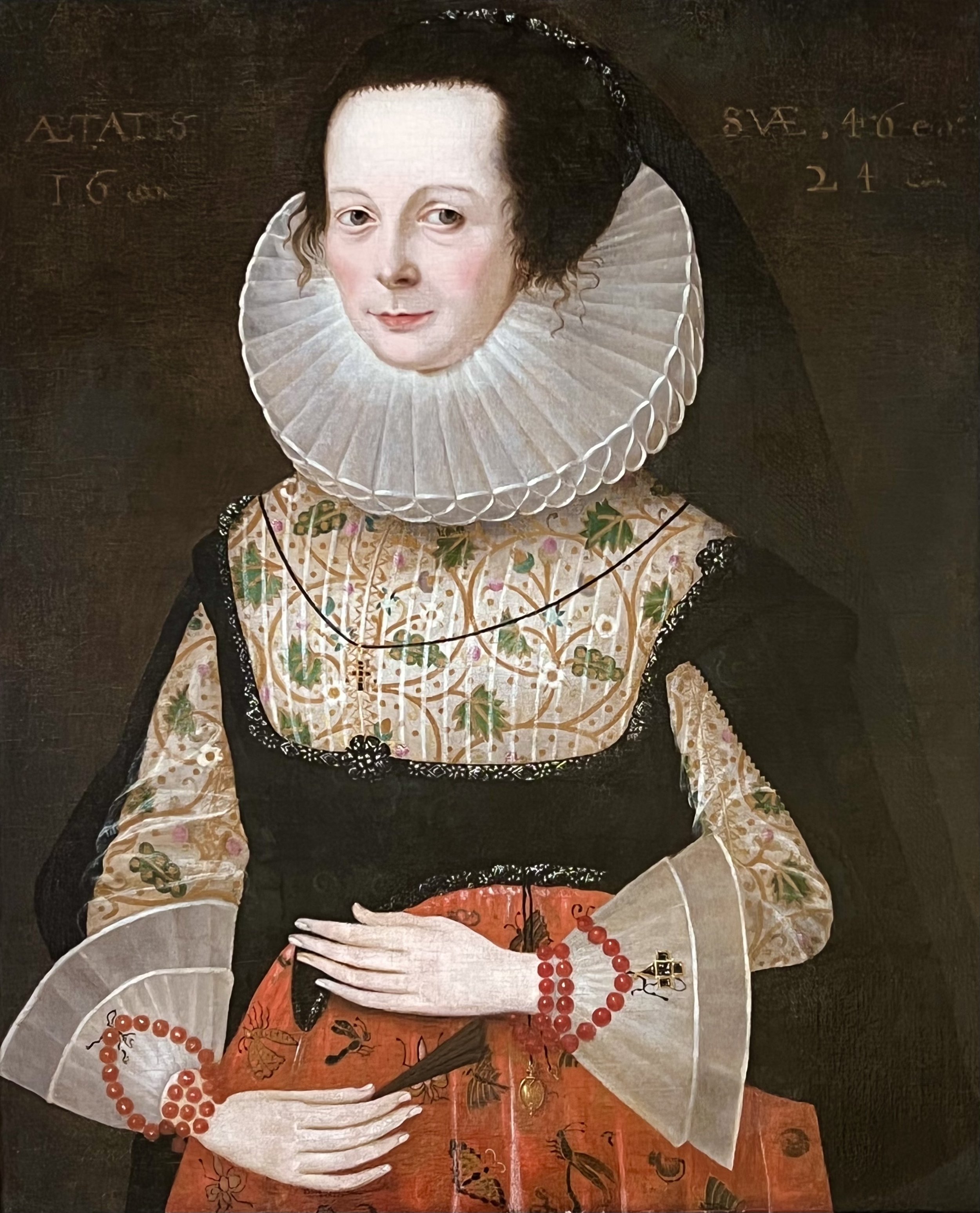
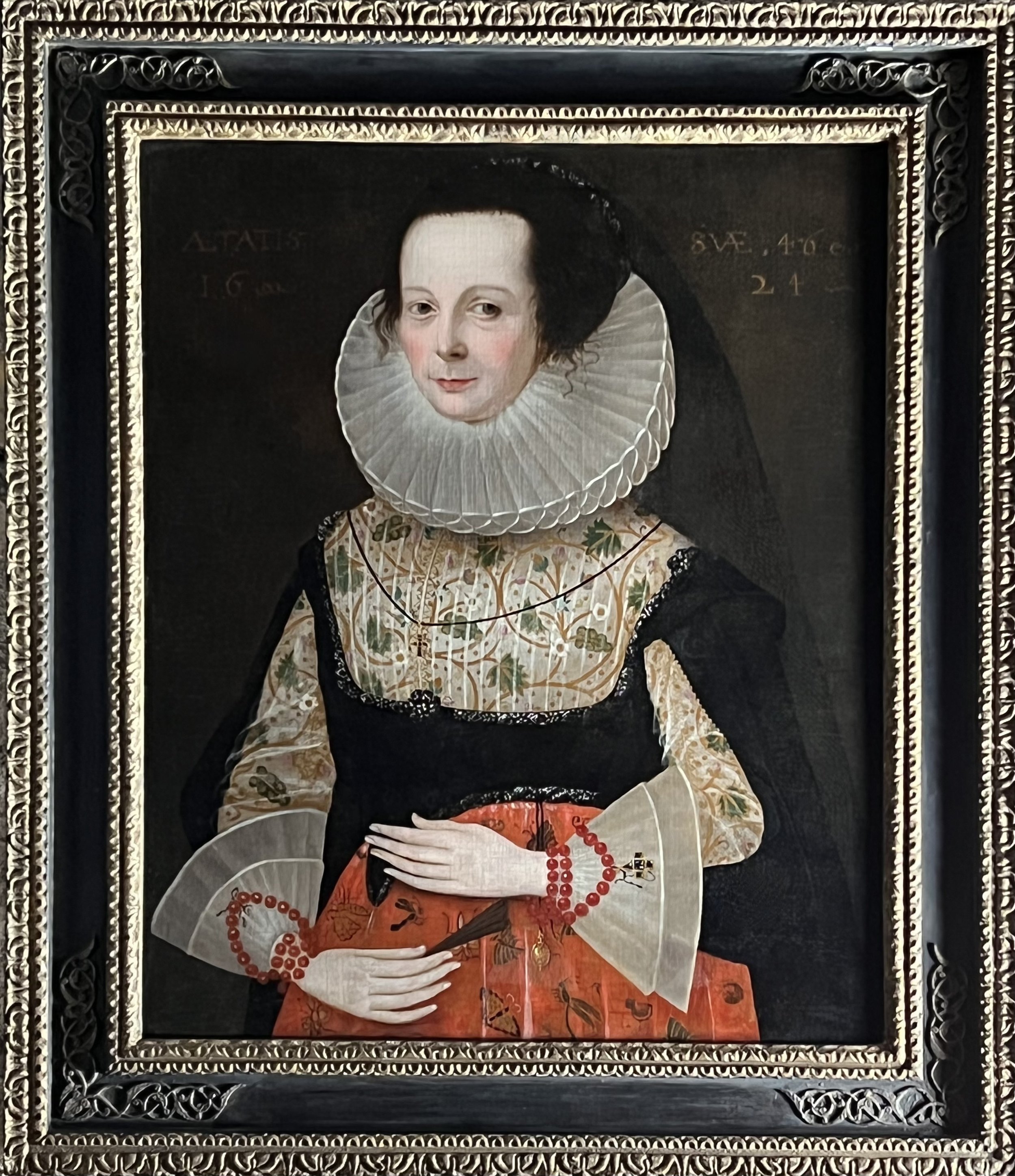
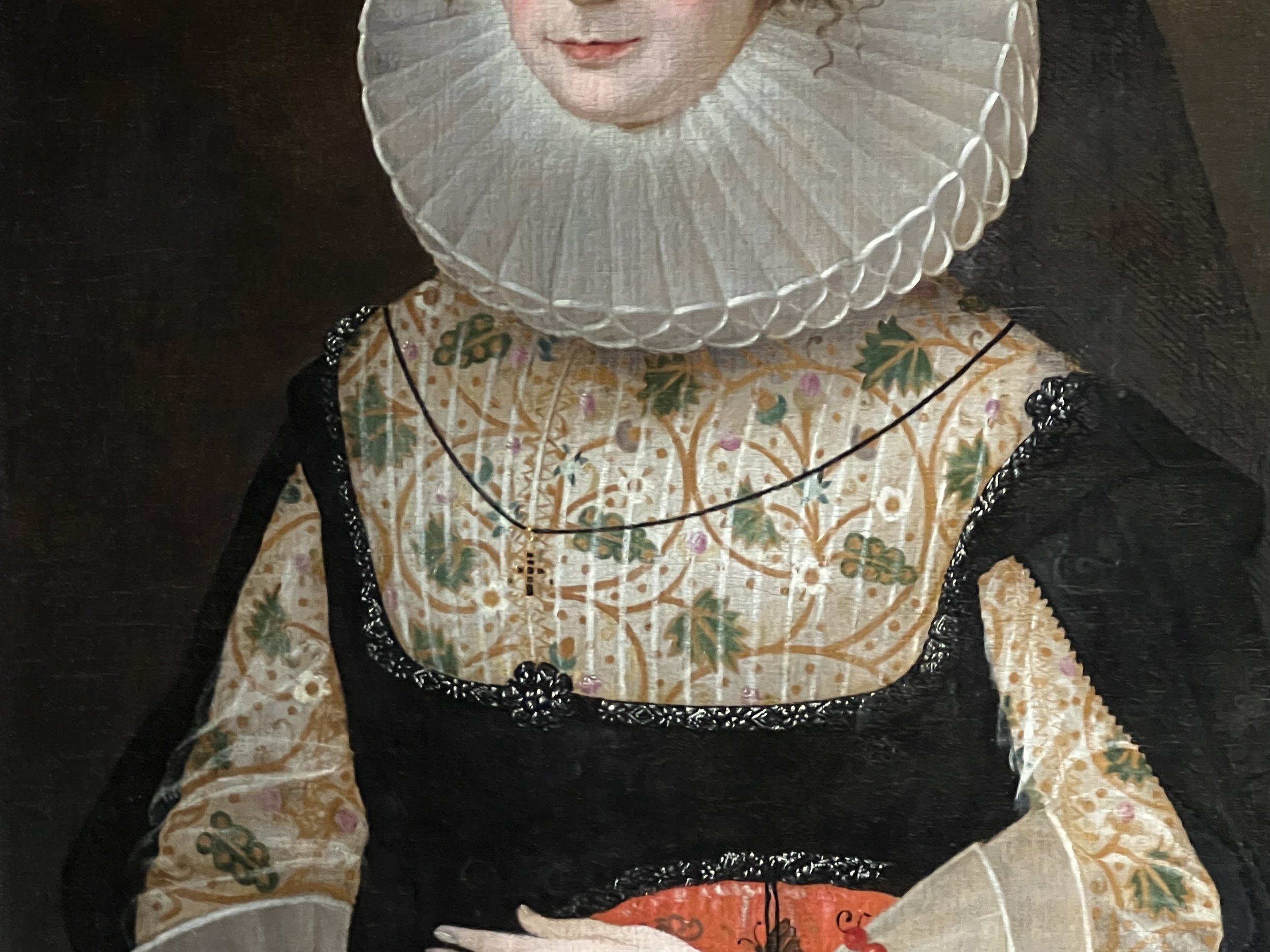

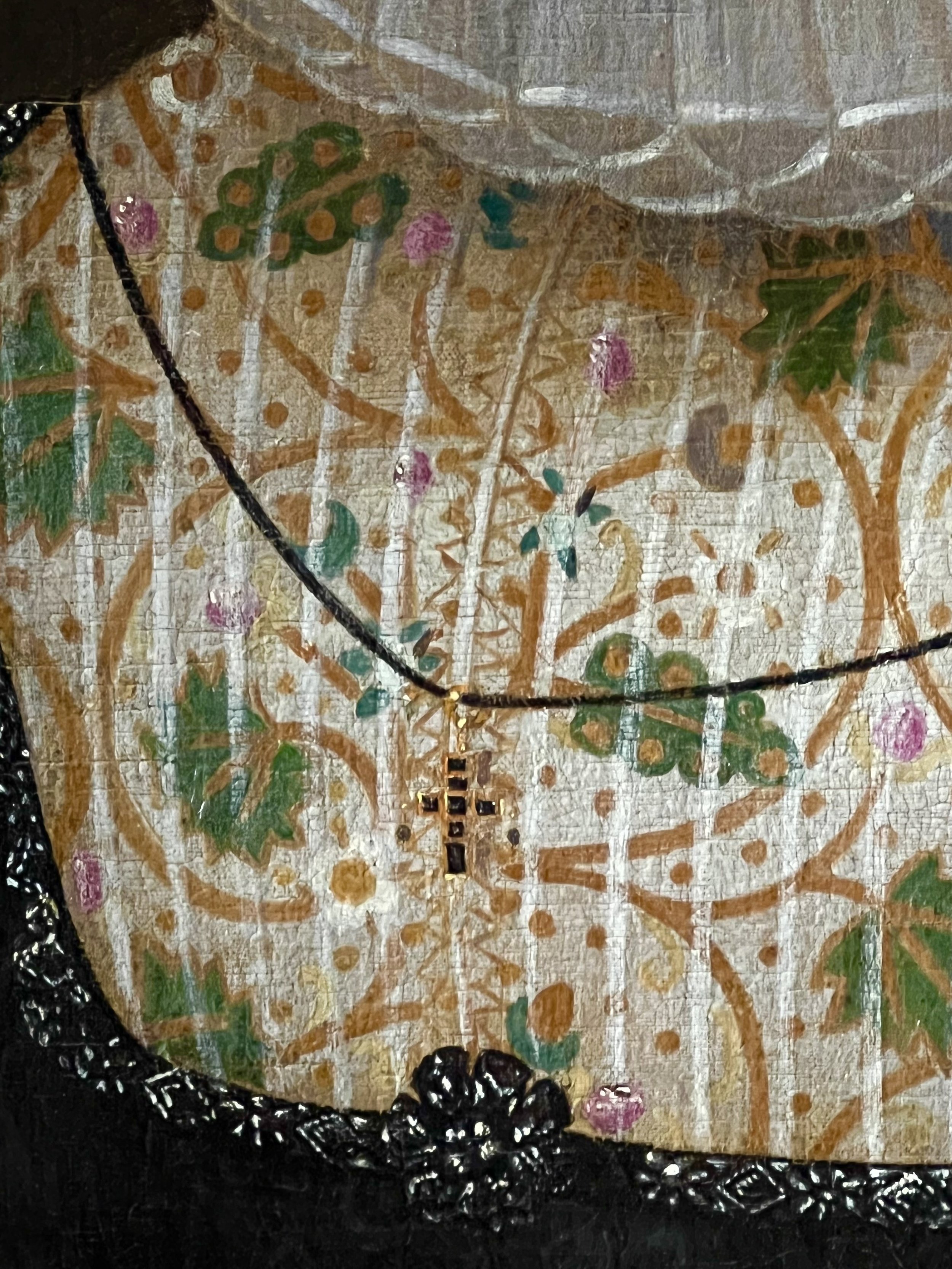
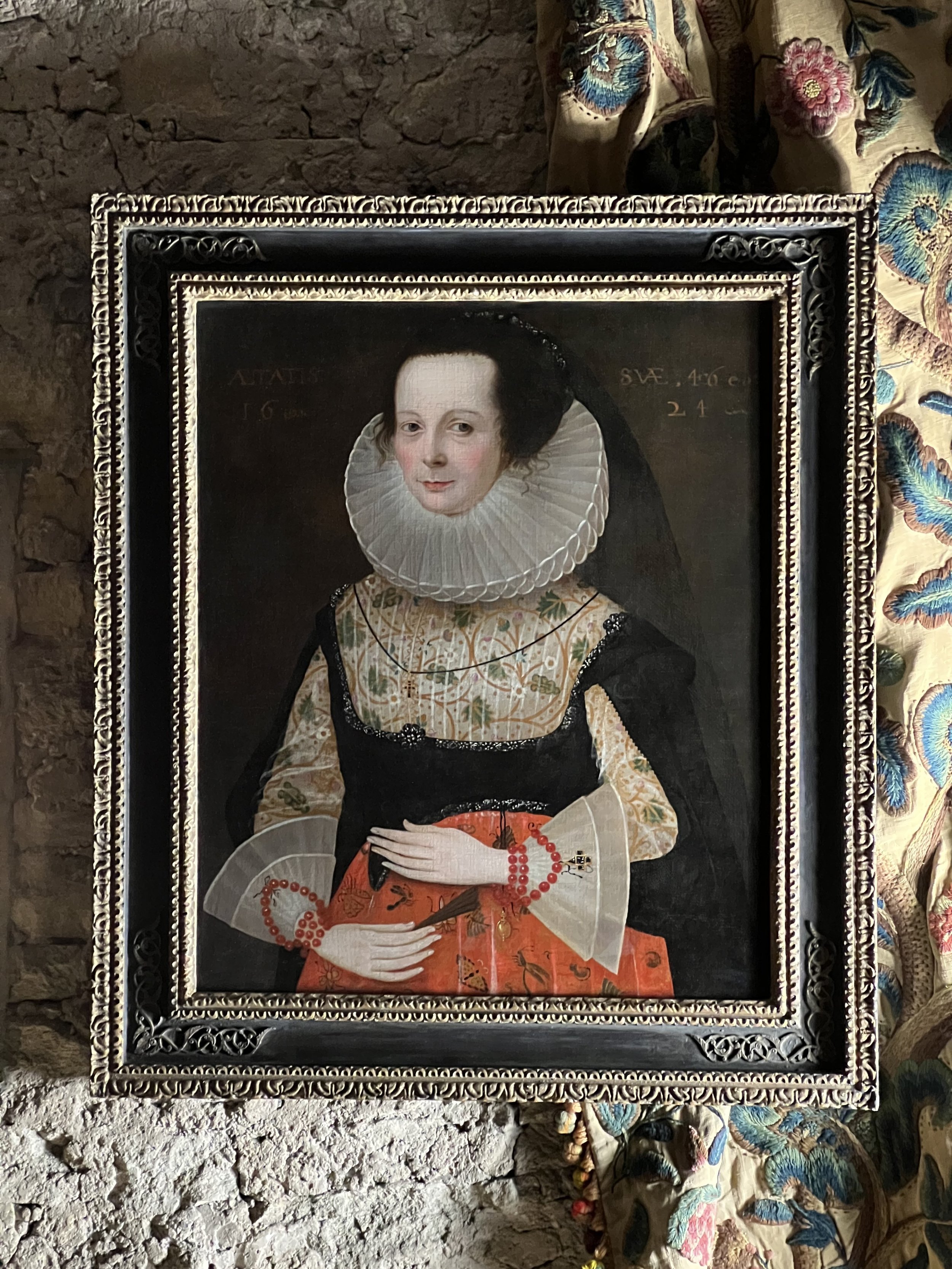
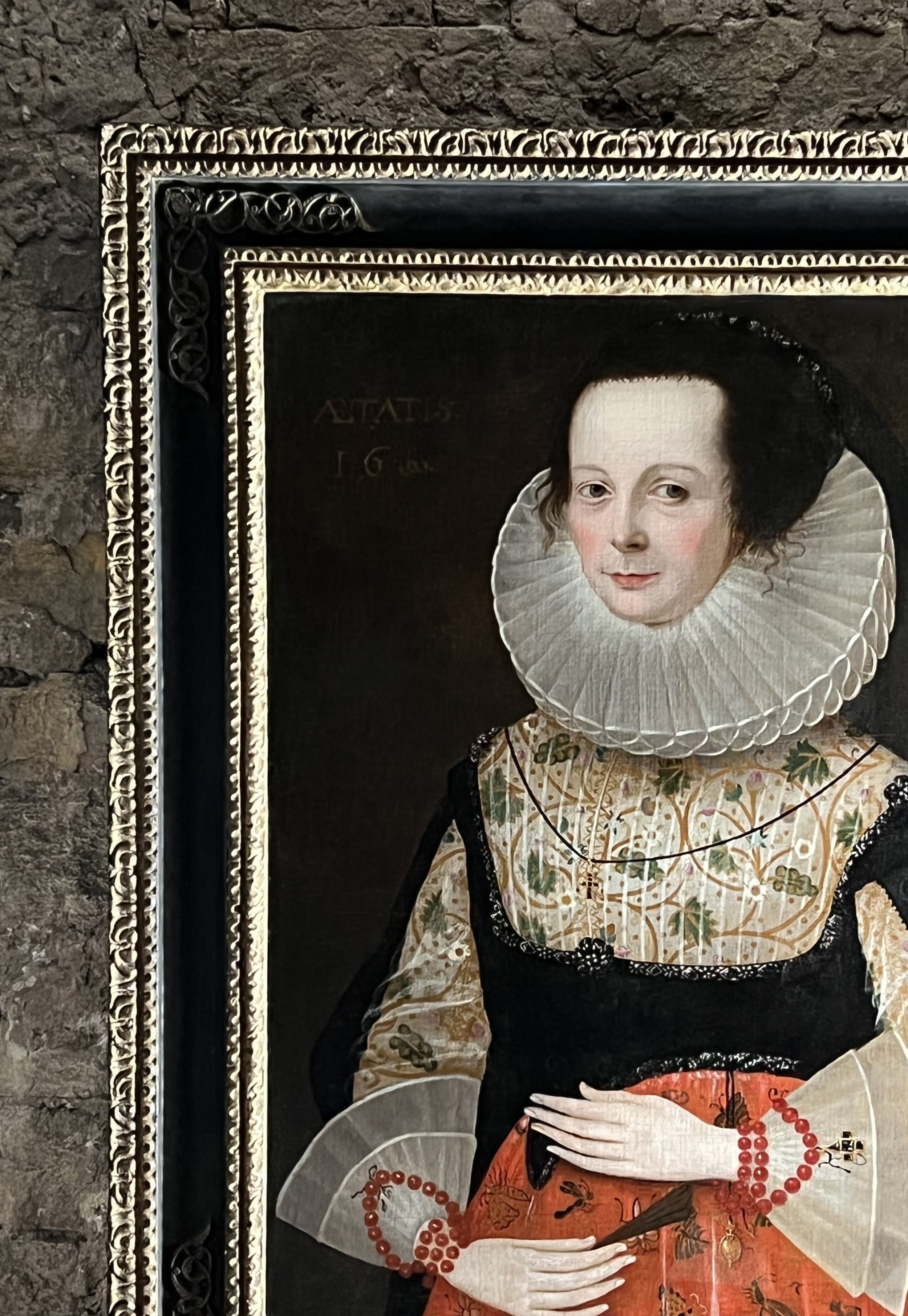
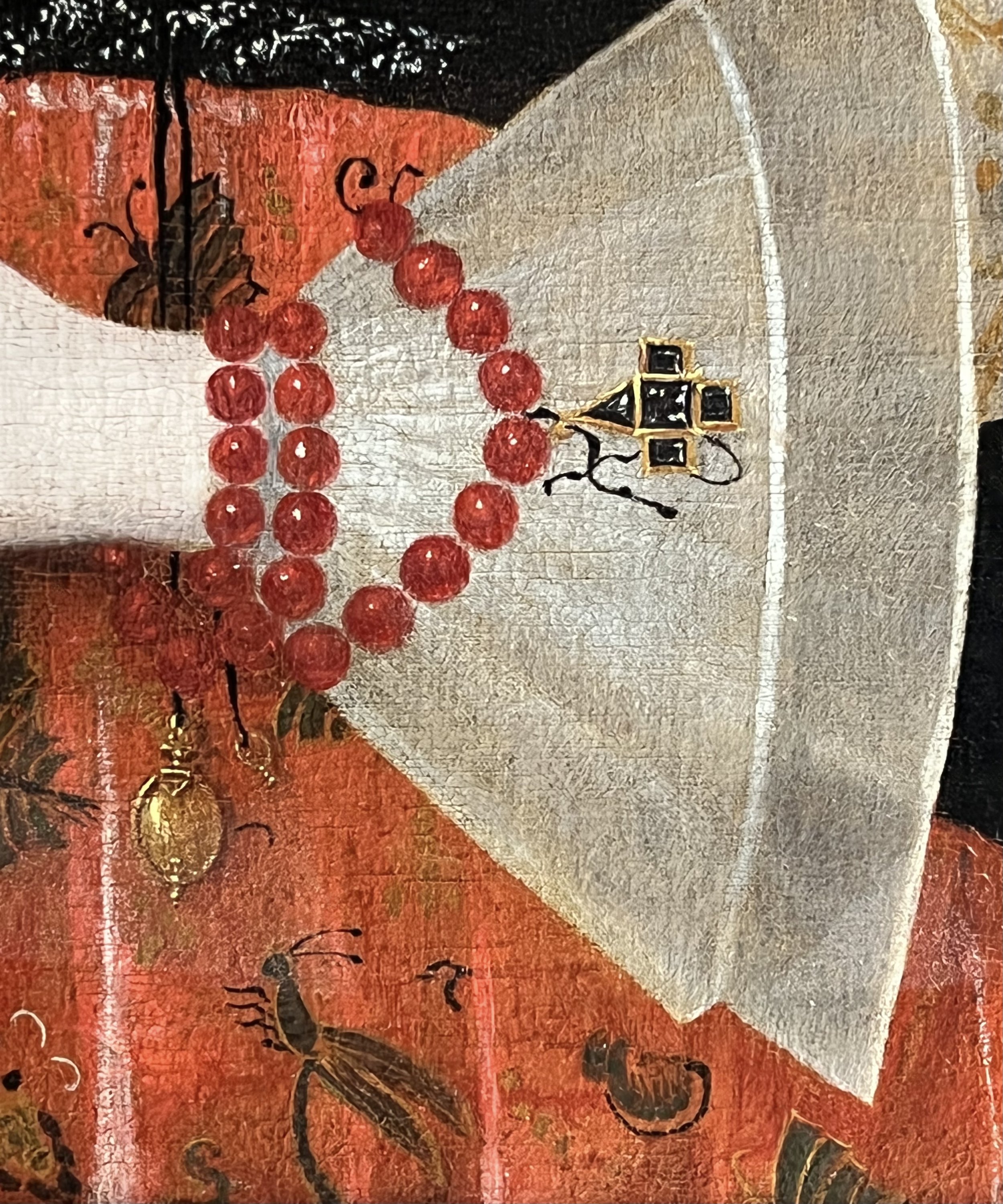
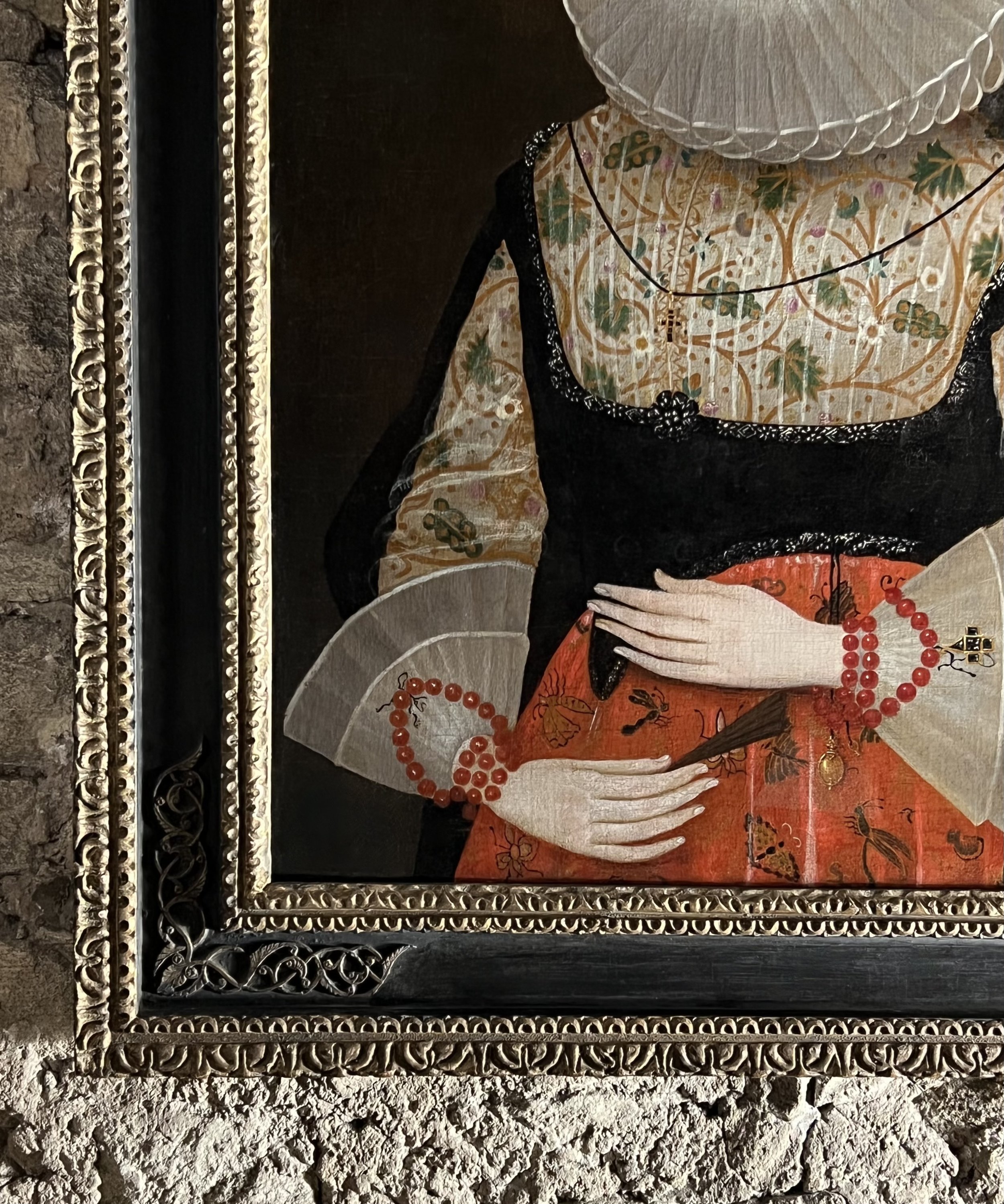
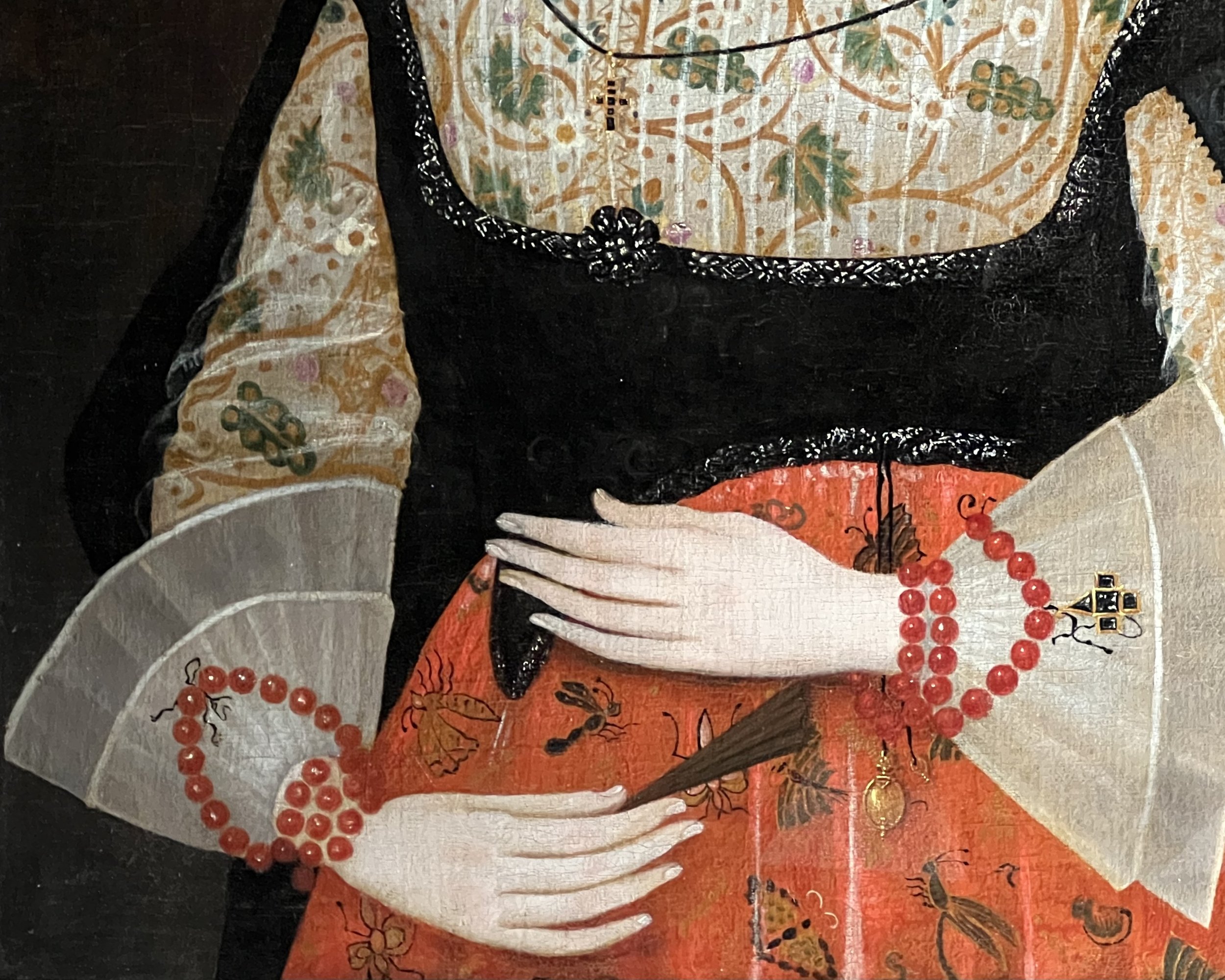
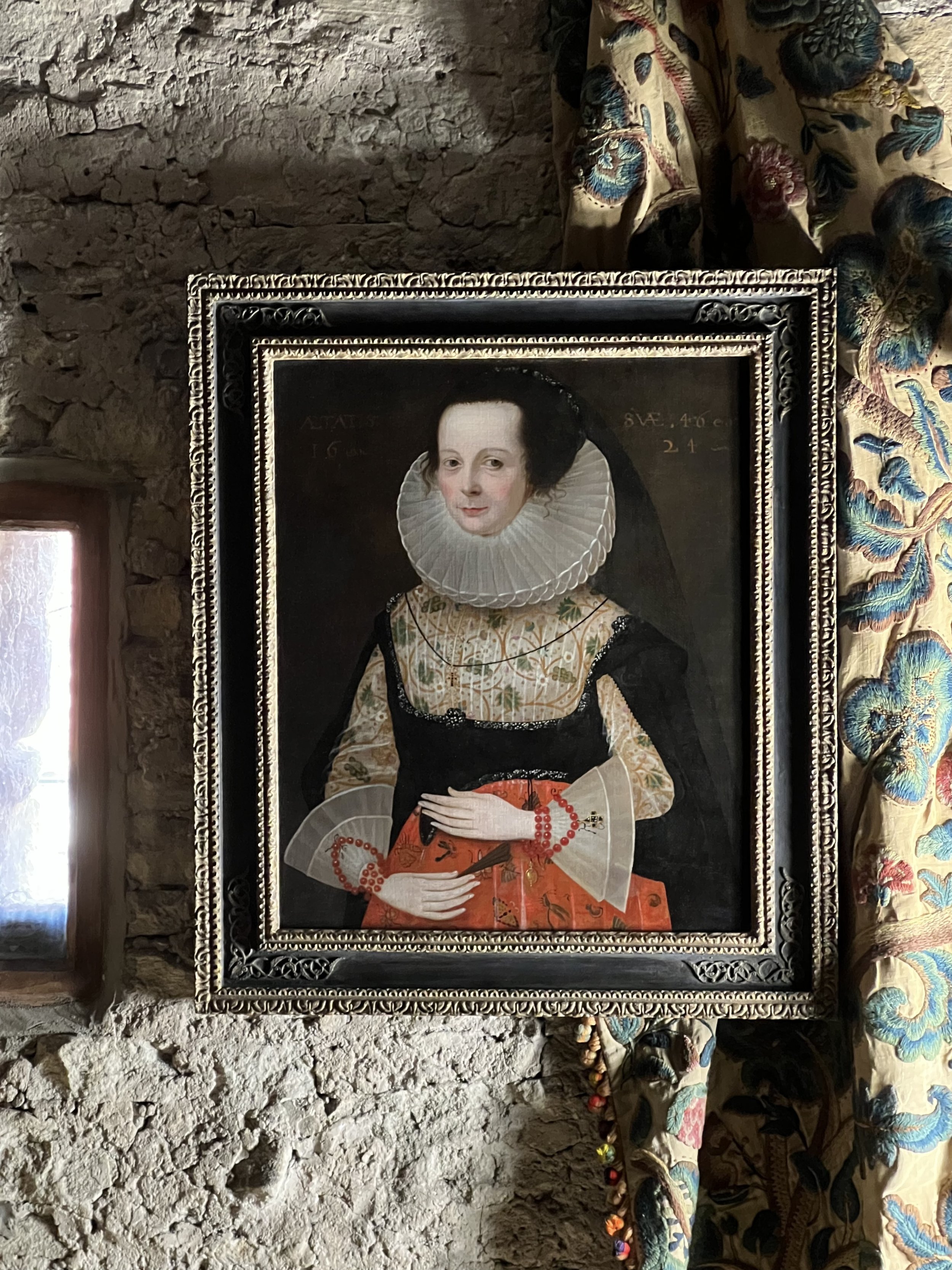
17TH CENTURY ENGLISH SCHOOL - PORTRAIT OF A LADY DATED 1624.
A sumptuous and highly detailed 17th century Jacobean oil on canvas portrait of a lady of significant wealth and status. She wears her finery, reveals her most virtuous characteristics and gazes at us with an air of confidence befitting her 46 years. A latin inscription gives us her age and the date (1624) and conveys with it the notion that the sitter is well read, and both her clothing and deportment tell us that she is well-bred.
Display is evidently important to this sitter. Her wealth and power are revealed in her choice of colours – red and black were both extremely expensive dyes. Many women would have worn black silk twists of ribbon at the wrist (and perhaps one beaded bracelet) to set off the desired pale complexion. This lady’s show of red beaded bracelets is ostentatious and they would have been heavy and difficult to keep in the desired position. They are secured to stiffened starched linen cuffs with black silk ‘twists’ to decorate and disguise the pin.
She invites us to admire her piety with a cross-shaped brooch, and perhaps the plainness of her linen (in place of very costly lace). Don’t be fooled however as the black stones that glisten from her wrist are in fact diamonds. With her golden locket, and another diamond cross round her neck, it is clear that she has worldly wealth in abundance.
The fashionable silhouette that she exhibits is consistent with the 1620’s – namely a hairstyle that is broad rather than high, with little straggles of hair – called ‘lovelocks’ spilling onto her ruff. The ruff is full and closed – i.e. not open at the front – and is raised up at the back. This would be supported by a stiffened pasteboard collar called a ‘pickadil’ or ‘underpropper’ or perhaps a wired contraption (a ‘supportasse’) that would keep the starched linen elevated.
Her natural/high waistline is consistent with this period, as is the amount of wrist showing and the fullness of the sleeves. By the late 1620’s to 1630 sleeves would be full and would have shrunk to reveal the forearm, thus giving poets another area of the body to praise in poetry, and for moralists to condemn as sinfully and shamelessly displayed.
The use of polychrome embroidery - adorning her waistcoat and petticoat - is typical of the Jacobean era (the age of James I (1603-1625). The fashionable silhouette that she exhibits is consistent with the 1620’s – namely a hairstyle that is broad rather than high, with little straggles of hair – called ‘lovelocks’ spilling onto her ruff. The ruff is full and closed – i.e. not open at the front – and is raised up at the back. This would be supported by a stiffened pasteboard collar called a ‘pickadil’ or ‘underpropper’ or perhaps a wired contraption (a ‘supportasse’) that would keep the starched linen elevated.
The most striking feature of the sitters costume is undoubtedly the wealth of embroidery on display . This could have been the work of a professional embroiderer or created by the lady of the house herself as a demonstration of her skills.The polychrome patterns that adorn her high-necked waistcoat had been in fashion since the end of the Elizabethan era. There is a beautifully worked linen waistcoat from the Burrell Collection, Glasgow which exhibits a very similar scrolling pattern of gold, enclosing strawberry flowers and oak leaves. It can also be seen in the remarkable portrait by Marcus Gheerearts the Younger of Margaret Layton in the V&A - where the real jacket worn in the portrait also survives.
The embroidery in this portrait is more stylised than in the examples cited, but the motifs of oak leaves, acorns, strawberry leaves and flowers are clearly identifiable. Strawberries had been a popular motif since Virginia strawberries had been brought back from the ‘new world’ in the late C16th.The mini-beasts, butterflies and bugs that creep and crawl over her petticoat would have been worked with a needle (rather than woven into the fabric). We can tell that because they are so individualised. Ideas for these motifs would have been gleaned from pattern books We know that the original and exquisite drawings by the talented Huguenot draughtsman Jacques Le Moyne de Morgues from the 1570’s had been turned into commercially-produced embroidery pattern books by the 17th century.
Our sitter would be wearing a T-shaped garment of washable linen next to the skin (a smock), and she also appears to wearing such a linen waistcoat (which we would call jacket) as it has sleeves. On top of the waistcoat/jacket a gown of black silk fabric is worn, adorned with a bold floral pattern that has been woven into the fabric. This gown has a tight bodice and open front, with seams embellished with black braid, and discreet rosettes centre-front and shoulder.
Surviving garments – and this painting – demonstrates the use of ‘oes’ or ‘spangles’ tiny ‘o’ shaped bits of metal that we could call sequins. These were sewn liberally onto the linen jacket between the embroidered scrolling motifs and would sparkle and catch the eye as the wearer moved. This sitter has an additional layer of silk gauze over her embroidered waistcoat which is arranged in fine vertical pleats over the chest area, and billows out over her arms. Close-up details reveal hanging sleeves – i.e. false sleeves that hang down at the back of the gown. She has drawn the tubular end of one of the long hanging sleeves to the front of her gown, and plays with it at her waist, enabling her to draw attention to her white hands and white lawn (fine linen) cuffs, as well as the superbly embroidered red skirt.
Of particular note is the sitters ruff which is closed and open set. A set is a figure-of-eight arrangement that is formed when the layers of linen are folded in concertina fashion and fixed with blob of wax or pin to create the ‘8’ shape. This shape could be closed set (i.e. tightly packed) or open set, where the perfect circles or ovals of the ‘8’ were formed tubular-shaped irons called ‘poking sticks’. These blunt-ended long tubes of metal were warmed in the fire and then poked into the ruff to set the starch. Around 50 metres of linen may have been used to make this garment, and up to 5 hours of starching would be required.
The clear contours of our ladies pure white ruff are set off by the gauzy veil (or ‘rail) that hangs from the back of her head and frames her face. This was a fashionable feature that Queen Elizabeth I herself had used to add interest to the back view of her figure.
All of note are the sitters own fine features. They have been enhanced with paint (both in real life and in the artist’s studio). This white complexion would have been created by the use of pastes derived from white lead, which would eat into the skin and necessitate the use of additional make up to cover the blemishes that it caused. The maidenly blush of her cheeks may have been created with cochineal (made from beetles), and the dark pupils of her eyes created with the help of a drop of ‘belladonna’ – another poisonous flower that made the pupils dilate.
So although our sitter declares her age in the inscription we could be forgiven for mistaking her for a younger woman.
Whether her beauty was real in life or not, the painter here has displayed her to best advantage. She wears finery that would have befitted her economic status, in order to impress her contemporaries as well as posterity. Her plan has worked as almost four hundred years later she continues to dazzle and excite.
I am most grateful to Jacqui Ansell, Senior Lecturer, Christie’s Education for the detailed information and analysis that she has provided on fashion and costume.
Provenance: The Weiss Gallery, London, 1988. Private collection Canada.
Higher resolution images on request. Worldwide shipping available.
Canvas: 30.5” x 25.75” / 78cm x 65cm Frame: 38.25” x 33.5” / 98cm x 89cm
Price: £44,000

